SL/R231: An SL550 Tour: The Rise and Fall of Newburgh, New York
#1
An SL550 Tour: The Rise and Fall of Newburgh, New York
Part 1
No one in their right mind drives from the Baltimore area up to Cape Cod. Slogging up the New Jersey Turnpike, laboring through or around New York City, and then potholing your way across Connecticut is nobody’s idea of fun. But a more circuitous route can create a memorable journey. This past June, I made a point of looking around Newburgh, New York. With a population of 28 thousand, Newburgh is not a large city, but a lot seems to have happened here—good, bad, and even ugly.
The Newburgh Conspiracy
After having sat in the garage for a while, the Mercedes-Benz SL550 was eager to get some solid exercise. It blasted up the dreaded NJT before the traffic got out of hand, roared along between the Raritan River and the campus of Rutgers University, made the Rahway to Mahway run in less than 12 parsecs, and crossed into New York State by noon. My first stop was the 1755 home of William and Jane Edmonston in Vails Gate.
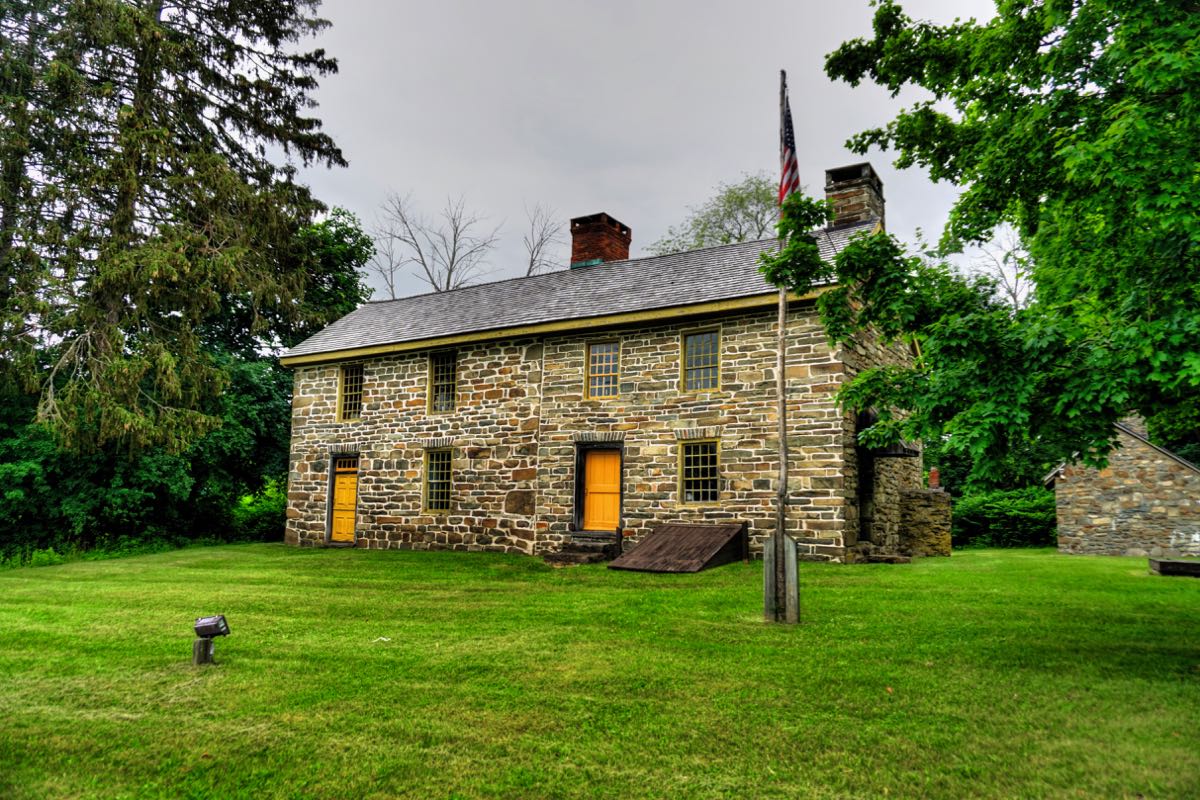
William’s parents had emigrated from Ireland to Colonial America in 1720, and 7 years later they settled here, initially in a log cabin. During the American Revolution, their stone house served as the headquarters of Colonial General Horatio Gates. Gen. Gates was apparently unhappy with his accommodations and wrote to George Washington in November 1782 asking to be reassigned to a fancier home nearby. As Gates put it, “Your Excellency’s Dog Kennel at Mount Vernon is as good a Quarter as that I am now in.” (His overwrought plea was to no avail.)

Did I mention how much fun I was having driving the SL550 along the back roads of New York? It’s not a light car, but with 449 horsepower it would still leap from corner to corner, and its wide, sticky tires and fairly even weight distribution provided more cornering grip than any sane person could fully use on public roads.

Meanwhile, back to George Washington, who was traveling by horse in March 1782 and no doubt wishing he had a SatNav, soft-close doors, and AirScarf… By this eighth year of the Revolutionary War, victory had already been secured by the siege of the British forces at Yorktown, Virginia and the surrender of General Charles Cornwallis. But the British still occupied New York City and Charleston, South Carolina, and the formal Treaty of Paris would not be signed for another 2 years. In 1782, Gen. Washington made his headquarters at this stone house in Newburgh, overlooking the Hudson River.

Despite the defeat of the British Army, not all was well in the fledgling United States. Washington’s army was malnourished, poorly supplied, and hadn’t been paid by Congress in nearly a year. (Under the Articles of Confederation at that time, Congress had no power to tax.) Many of Washington’s officers at Newburgh, facing the disbanding of the army, began to consider ways to force Congress to make good on their promised back pay and pensions.
In May 1782, at the bequest of these officers, Colonel Lewis Nicola wrote to Gen. Washington, describing the concerns of the officers and troops and proposing a means by which to settle the debts. In the process, he injudiciously noted that the army might refuse to stand down until they were paid, thereby posing a mutinous threat to Congress and the new government of the U.S. For good measure, Col. Nicola argued the merits of republics versus monarchies and suggested that a “republican monarchy” might be the best solution. Not stopping there, he stated “strong arguments might be produced for admitting the title of king…” Although he did not directly propose making Washington the king of the United States, Washington himself (and most early historians) interpreted the proposal as such. Gen. Washington wrote a scathing response to Col. Nicola, including “Be assured, Sir, no occurrence in the course of the War has given me more painful sensations than your information of there being such ideas existing in the Army as you have expressed, & I must view with abhorrence, and reprehend with severity.”

Washington’s response to Nicola left the latter abashed and ashamed. He sent four letters of apology, and neither man mentioned the incident again. Later that year, with winter coming, Gen. Washington needed a winter encampment for the 7,000 soldiers in the northern portion of his army. Based on advice from William Edmonston, he picked a large area north of Vails Gate and west of New Windsor. Here, his Continental Army built 600 log huts, a number of larger buildings, and a long, narrow meeting hall named the “Temple of Virtue.”
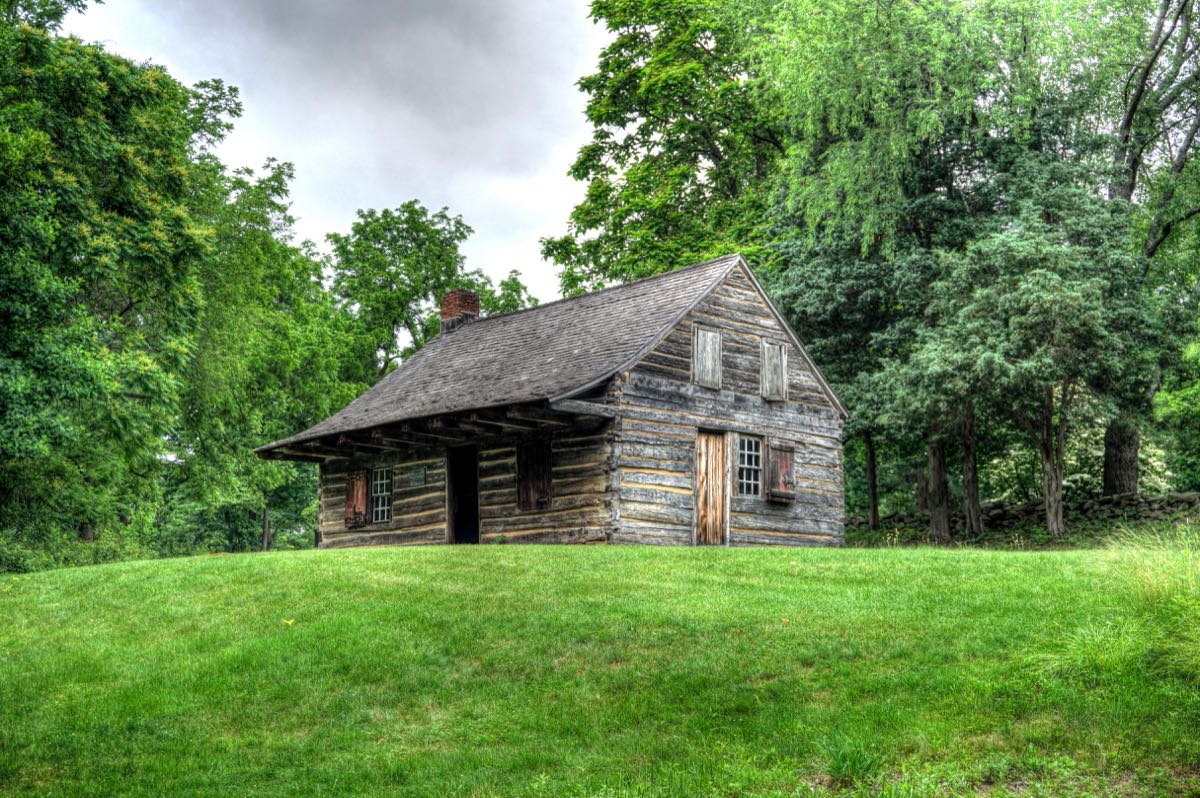



Meanwhile, the officers of the Continental Army remained agitated. In March 1783, a sizable group of them sent a letter to Congress voicing their concerns and adding “any further experiments on [our] patience may have fatal effects.” Congress considered this letter but could not reach agreement on how to proceed, and the officers began voicing further veiled threats, including even an outright attack on Congress. An anonymous letter circulated in the camp calling for a meeting the following day at the Temple of Virtue to plan a forceful ultimatum to Congress. The letters were (correctly) believed to have been written by Major John Armstrong, on behalf of Gen. Horatio Gates—who, in addition to disliking his lodgings, was a longtime rival to George Washington.
At the appointed meeting, George Washington unexpectedly appeared and asked for the opportunity to speak. He proceeded to deliver the “Newburgh Address,” calling on his officers “not to take any measures, which, viewed in the calm light of reason, will lessen the dignity, and sully the glory you have hitherto maintained.” He added, “And let me conjure you, in the name of our common country; as you value your own sacred honor; as you respect the rights of humanity; as you regard the military & national character of America, to express your utmost horror & detestation of the man who wishes, under any specious pretences, to overturn the liberties of our country, & who wickedly attempts to open the flood gates of civil discord, & deluge our rising empire in blood.”
Washington concluded by starting to read a letter from a member of Congress—but after struggling with the first paragraph, he said to the officers, “Gentlemen, you will permit me to put on my spectacles, for I have not only grown gray but almost blind in the service of my country.” His stunned officers were abruptly reminded of Washington’s own sacrifices in the formation of the new country, and in an instant the conspiracy disintegrated. The officers immediately drafted a resolution in support of Washington’s position and in opposition to Gen. Gates’ anonymous proposal. The principles underlying the new republic—including civilian control of the military—were proven in action, and Washington once again earned the heartfelt approbation of his country. (Jane Sutherland painting courtesy of American History Central.)

Okay, so I might have been a bit flippant in suggesting that George Washington had soft-close doors and AirScarf on his mind…
The 1782-1783 winter encampment was designed to be temporary, and it was soon dismantled. More recently, the camp has been partially reconstructed, and it now serves as the New Windsor Cantonment State Historic Site. This monument commemorates the Continental Army (and could use a bit of re-leveling).

Sharing the Cantonment Site is the National Purple Heart Hall of Valor, although it was closed for renovation on the day of my visit. George Washington had first created and bestowed the “Badge of Military Merit” here, which featured a heart made of purple cloth. In 1932, on the 200th anniversary of Washington’s birth, Gen. Douglas MacArthur revived the medal and named it the Purple Heart.

As I left the historic site, I discovered a small graveyard behind the monument. It turned out to be a very early monument to an unknown soldier.
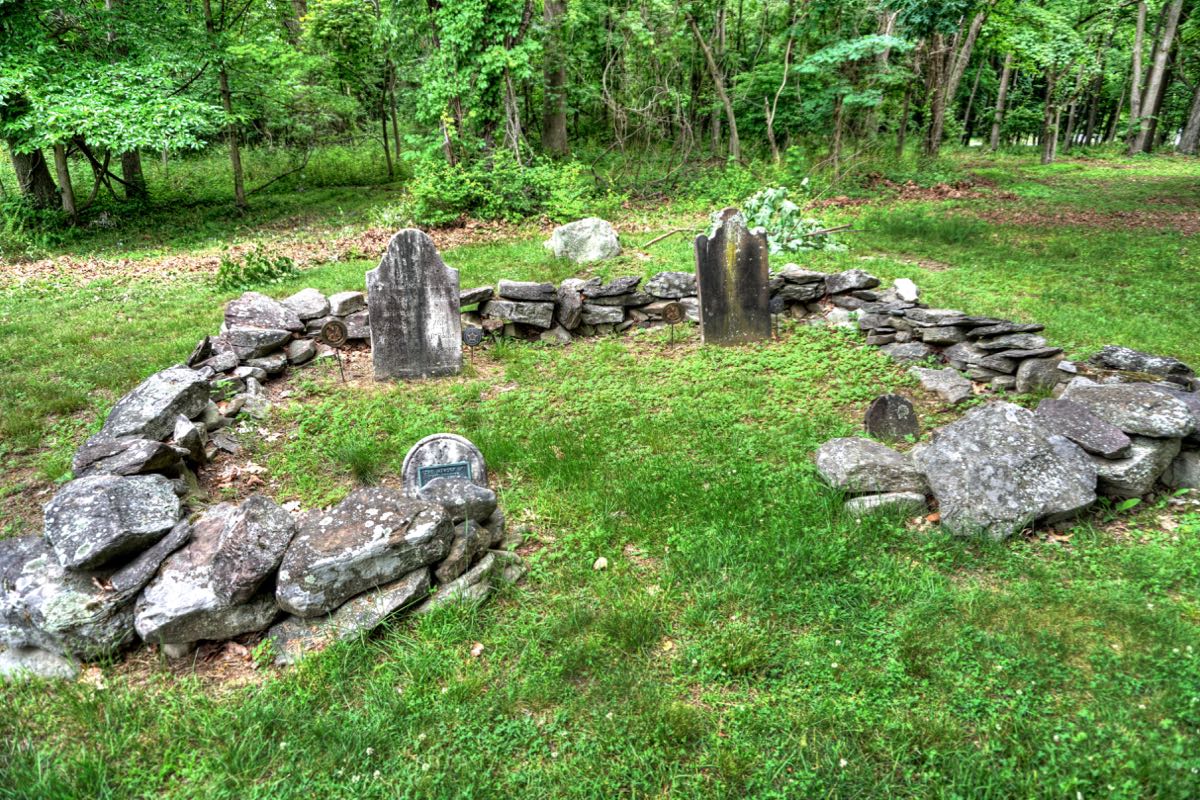

A mysterious building at a mysterious airport
A few miles from the Temple of Virtue, I found myself on the grounds of Stewart International Airport, just outside of Newburgh. Fans of the TV series “Manifest” will recognize this as the airport where Flight 828 landed—more than 5 years after it had taken off from Jamaica. It is also home to the New York National Guard’s 105th Airlift Wing. I parked at an empty lot, next to this massive and unusual abandoned building.

The monolith had zero windows. Out back, there appeared to be a large power generation station. There was only one entrance, which led to a heavy (and locked) metal door. All in all, it was a rather strange place.


In September 1949, the U.S. was shocked to discover that the Soviet Union had tested an atomic bomb. Up to that point, only the U.S. had nuclear weapons, and the Pentagon was painfully aware that there were no effective defense systems protecting against an airborne Soviet nuclear attack. Although a multitude of radar sites scanned the skies around the U.S., they produced a hodge-podge of signals, including commercial aircraft, U.S. and Canadian military flights, flocks of geese, and you name it. Identifying possible hostile attackers among the massive amounts of data was impossible for human observers, and no existing computers could handle such a challenge.
This situation led to the creation of about two dozen “Semi-Automatic Ground Environment” (SAGE) buildings around the country. Each one contained the largest digital computer ever built—then or now. These IBM AN/FSQ-7 computers were created expressly for the purpose of identifying potential enemy bombers and calculating the most effective interception routes for American fighter jets and/or NIKE and BOMARC surface-to-air missiles. To accelerate the design of such computers, the military joined forces with the Massachusetts Institute of Technology’s nascent “Whirlwind” computer effort, which was being developed for use as a flight simulator. (Back then, there were no effective flight simulators; the computations required were too overwhelming. Since the late 1980s, of course, anyone with a Mac or PC and $50 could have a highly accurate simulator.)

The SAGE installation at Newburgh was the second such facility to go into operation, on June 26, 1958. The massive AN/FSQ-7 computer weighed 250 tons and occupied the whole of the second story of the building shown. It used approximately 49,000 vacuum tubes (!), which were periodically replaced in banks, based on their known operational life. Each computer comprised two separate halves, one of which would mirror the opposite one as it operated. These computers also employed magnetic core memory for the first time, which was a huge breakthrough in speed and reliability. Data from the myriad of radar sites were translated into digital signals, sent in by telephone lines, and then coordinated with known commercial and military flight schedules. The SAGE computer could also interface with airbases and guided missile sites—even to the point of sending directional data to the autopilot systems of Air Force fighter jets.

The SAGE computer had to operate in real time, which was not previously possible. Moreover, it had to provide a visual image that consolidated the data and made it easily interpretable by operators. The first practical computer “display scopes” (monitors) were invented for this purpose.

The fourth floor of the SAGE building housed bank after bank of these consoles, which were monitored around the clock by Air Force personnel. One group looked for unidentified flight vectors, with results transferred to an identification group. Any bogies identified as hostile would be sent to the “weapons direction” group for action to intercept and destroy.
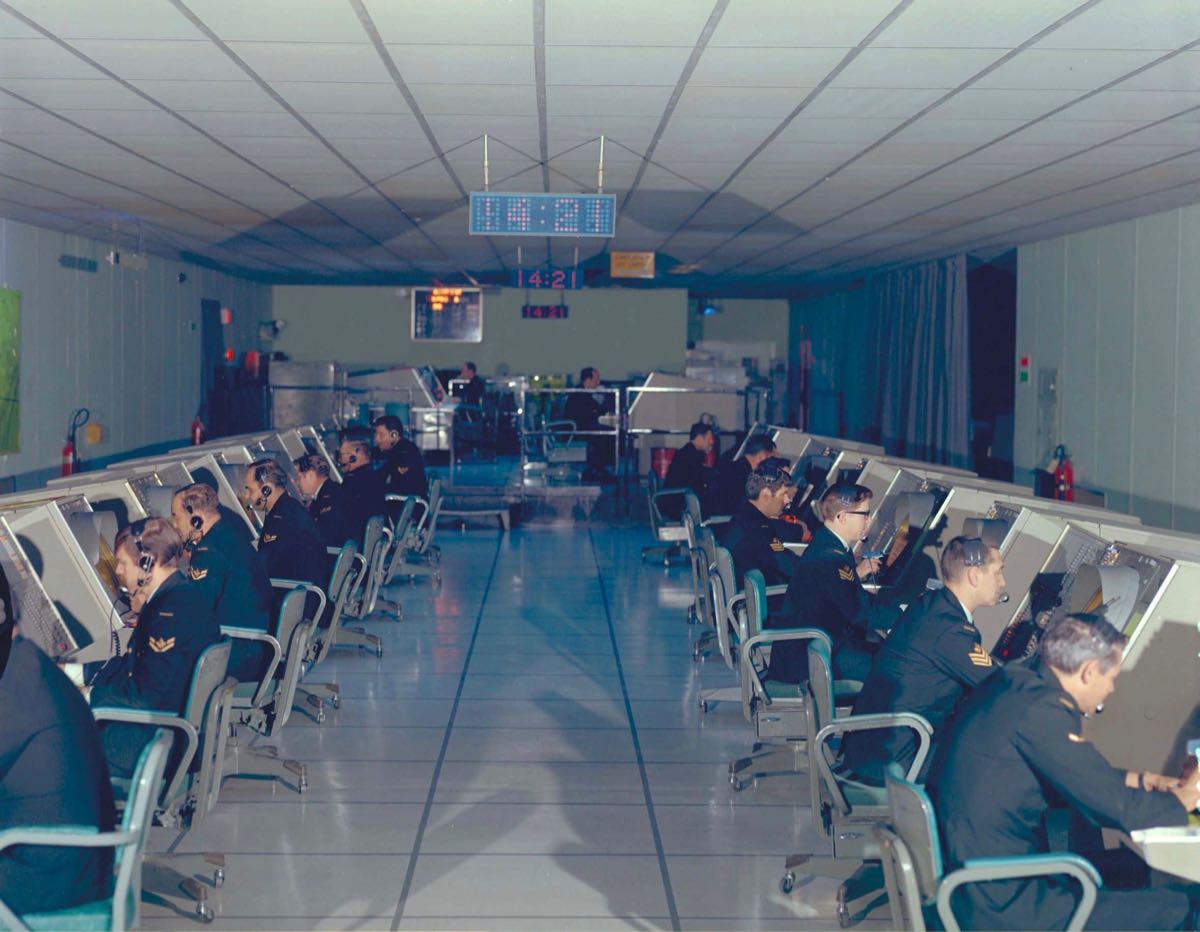
Due to the weak contrast of the displays, the rooms were dimly lit by special blue lights. Operators could use an inventive “light gun” to register any points of interest with the computer, which would then show additional data for the object in question.

The third floor contained the “Sector Command Center,” which would assess threats identified by the computer and operators and, if necessary, alert military airbases and provide flight paths for intercepting the attackers. It featured a large-scale projection map showing the full status of air defenses, strategic threats, and other information simultaneously. The entire building was heavily reinforced against the force of a nuclear attack and shielded from associated electromagnetic pulses.

Did I mention the ground floor? It contained miles of pipes circulating cold water to help keep the massive computer from overheating. The SAGE facilities represented astonishing technological advancement for the time, but they became largely obsolete by the mid-1960s with the advent of intercontinental ballistic missiles, which were too fast for SAGE to track. The SAGE systems around the country continued in diminishing use until the early 1980s, but by then they had been supplanted by Airborne Warning and Control System (AWACS) aircraft, with vastly superior technology.
As for the abandoned SAGE building outside of Newburgh, NY, it serves as an important reminder of the now taken-for-granted concept of national defense. The massive SAGE computers are long gone, but some pieces of them are in computer museums and others have served as a backdrop for numerous movies, including “Fantastic Voyage,” “Planet of the Apes,” “Sleeper,” “Westworld,” Airplane!,” “War Games,” “SuperGirl,” and a great many others. (The AN/FSQ-7 on TV and in the Movies has a listing of such shows, together with sample screen images including the two shown below.) At Newburgh, local Air National Guard members say that the fourth floor still contains much of its old equipment.

What I wouldn’t give to get an inside tour of the place! (Historical photos courtesy of Wikipedia, The Lincoln Library, IBM, and The War Zone.)
There are motorcycles in Orange County, NY
It goes without saying that any modern car, including my SL550, harnesses far more computing power than an entire 250-ton IBM AN/FSQ-7. Such is progress over the last 65 years. And an SL550 will accelerate far faster than any car available in the 1950s, stop shorter, and get vastly better gas mileage at the same time. (And it has AirScarf…)

I reluctantly left the old SAGE building and arrived shortly at this quaint stone building. It was part of the Orange Mills gunpowder factory complex, which operated from 1815 to 1908. Now part of Algonquin Park near Newburgh, there are at least two dozen building ruins hidden among the trees and bushes, along with the original three ponds that supplied water power to operate all of the machinery. This cylindrical building was the “wash and change house,” where workers could clean up after a day of mixing, grinding, pressing, and packaging black powder for rifles and “recreational use.”

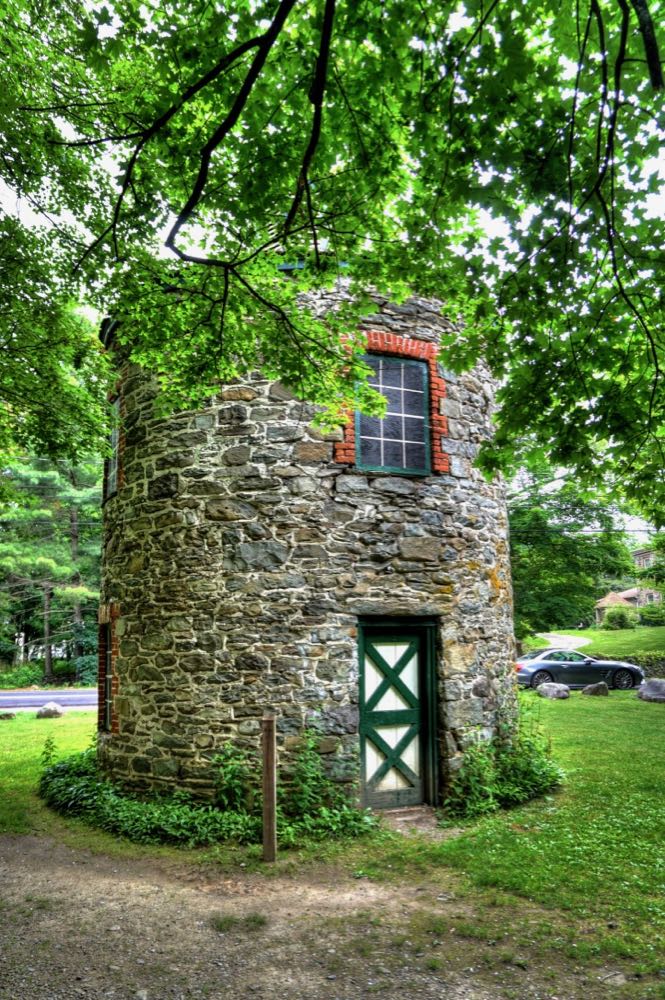
Even before the gunpowder mill, one Elnathan Foster (no relation, probably) operated a sawmill here as early as 1790. Asa Taylor bought the property in 1815 and built the gunpowder factory—but after three explosions in the first three years of operations, he wisely sold the factory to someone else. I would have loved to roam this park for a couple of hours, but I still had to drive another 260 miles to Cape Cod by evening. I’ll be back! (Ruin photos courtesy of Wikipedia and the Times Hudson Valley.)


Next up was a visit to Motorcyclepedia, a large museum with over 600 historic and modern motorcycles, including about 100 Indian cycles from the classic era (1901-1953). The museum has several galleries, each dedicated to a particular branch of motorcycle history. It also has two operational “Wall of Death” motordromes, with occasional demonstrations. The Chopper Gallery featured any number of custom bikes by such well-known builders as Arlen Ness and Ed Roth. (Interestingly, the original Orange County Choppers, which I always assumed was in California, was located just a few miles away.)

As a big fan of 1960s motorcycle road racing, I particularly enjoyed this Harley-Davidson.

Motorcycle racing was very popular in the early 1900s. The 1910 Merkel was the class of its field in both racing and road use back in the day.
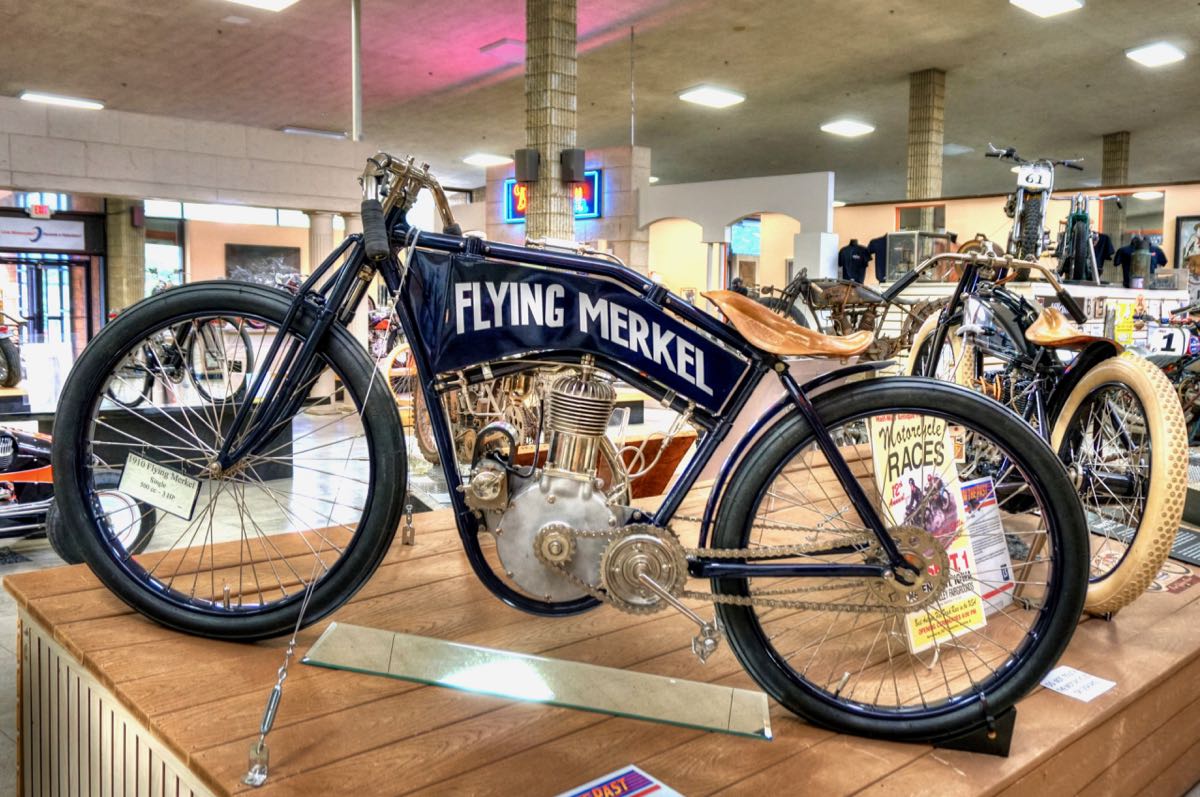
This 1915 Harley-Davidson used 4 valves per cylinder and produced 55 horsepower from its 61 cubic inch displacement. In its day, Harley beat all the other challengers to win the prestigious Dodge City 300 on a 2-mile dirt track.

Board track racing was very popular in the 1920s—and extremely dangerous. Riders could exceed 100 mph on the steeply banked tracks, and the motorcycles had no brakes, front or rear! Moreover, it cost a lot to maintain the board surfaces in good condition, so broken or even missing boards were not uncommon, and Major Splinters were a serious problem. This 1922 ACE was a successful board track racer.
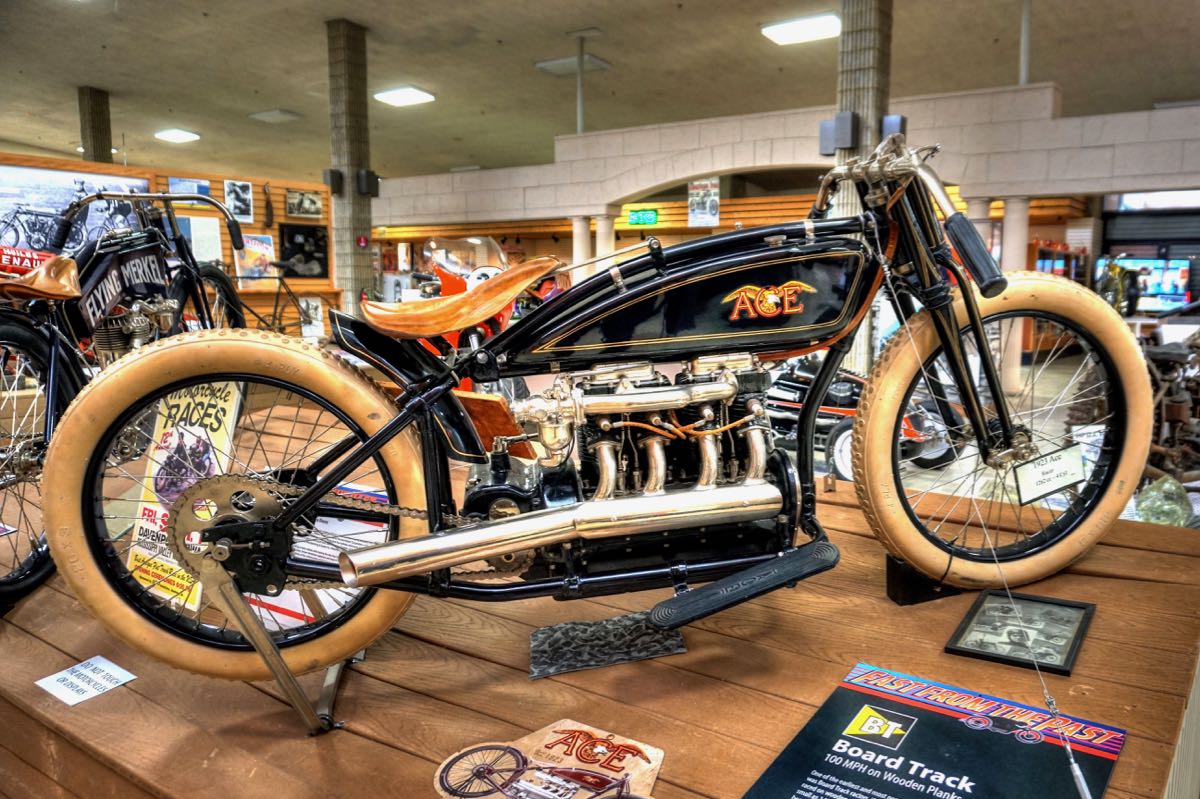
The museum’s motordromes are about 32 feet in diameter, and bikes like this 1920s Indian Scout can circulate horizontally within the cylinder at speeds of 30 mph or so. Riders can go faster, but the higher g-forces have a nasty tendency to drain blood from the brain, causing unconsciousness—and crashes. Watch I would like to do. Ride, not so much!

Another gallery had a series of movie and TV motorcycles, including Batman and Robin’s sidecar rig…

…a “LightCycle” from the movie Tron…

…and replicas of Peter Fonda’s and Dennis Hopper’s choppers from “Easy Rider.” (If you’ve seen the movie, you understand why only replicas are available!)


As I left the museum, I had to admire this literal mish-mash motorcycle sculpture. My own total of two “off’s” during my motorcycling career never resulted in a bike that I wasn’t able to continue riding. I suspect the same cannot be said of these machines.

No one in their right mind drives from the Baltimore area up to Cape Cod. Slogging up the New Jersey Turnpike, laboring through or around New York City, and then potholing your way across Connecticut is nobody’s idea of fun. But a more circuitous route can create a memorable journey. This past June, I made a point of looking around Newburgh, New York. With a population of 28 thousand, Newburgh is not a large city, but a lot seems to have happened here—good, bad, and even ugly.
The Newburgh Conspiracy
After having sat in the garage for a while, the Mercedes-Benz SL550 was eager to get some solid exercise. It blasted up the dreaded NJT before the traffic got out of hand, roared along between the Raritan River and the campus of Rutgers University, made the Rahway to Mahway run in less than 12 parsecs, and crossed into New York State by noon. My first stop was the 1755 home of William and Jane Edmonston in Vails Gate.

William’s parents had emigrated from Ireland to Colonial America in 1720, and 7 years later they settled here, initially in a log cabin. During the American Revolution, their stone house served as the headquarters of Colonial General Horatio Gates. Gen. Gates was apparently unhappy with his accommodations and wrote to George Washington in November 1782 asking to be reassigned to a fancier home nearby. As Gates put it, “Your Excellency’s Dog Kennel at Mount Vernon is as good a Quarter as that I am now in.” (His overwrought plea was to no avail.)

Did I mention how much fun I was having driving the SL550 along the back roads of New York? It’s not a light car, but with 449 horsepower it would still leap from corner to corner, and its wide, sticky tires and fairly even weight distribution provided more cornering grip than any sane person could fully use on public roads.

Meanwhile, back to George Washington, who was traveling by horse in March 1782 and no doubt wishing he had a SatNav, soft-close doors, and AirScarf… By this eighth year of the Revolutionary War, victory had already been secured by the siege of the British forces at Yorktown, Virginia and the surrender of General Charles Cornwallis. But the British still occupied New York City and Charleston, South Carolina, and the formal Treaty of Paris would not be signed for another 2 years. In 1782, Gen. Washington made his headquarters at this stone house in Newburgh, overlooking the Hudson River.

Despite the defeat of the British Army, not all was well in the fledgling United States. Washington’s army was malnourished, poorly supplied, and hadn’t been paid by Congress in nearly a year. (Under the Articles of Confederation at that time, Congress had no power to tax.) Many of Washington’s officers at Newburgh, facing the disbanding of the army, began to consider ways to force Congress to make good on their promised back pay and pensions.
In May 1782, at the bequest of these officers, Colonel Lewis Nicola wrote to Gen. Washington, describing the concerns of the officers and troops and proposing a means by which to settle the debts. In the process, he injudiciously noted that the army might refuse to stand down until they were paid, thereby posing a mutinous threat to Congress and the new government of the U.S. For good measure, Col. Nicola argued the merits of republics versus monarchies and suggested that a “republican monarchy” might be the best solution. Not stopping there, he stated “strong arguments might be produced for admitting the title of king…” Although he did not directly propose making Washington the king of the United States, Washington himself (and most early historians) interpreted the proposal as such. Gen. Washington wrote a scathing response to Col. Nicola, including “Be assured, Sir, no occurrence in the course of the War has given me more painful sensations than your information of there being such ideas existing in the Army as you have expressed, & I must view with abhorrence, and reprehend with severity.”

Washington’s response to Nicola left the latter abashed and ashamed. He sent four letters of apology, and neither man mentioned the incident again. Later that year, with winter coming, Gen. Washington needed a winter encampment for the 7,000 soldiers in the northern portion of his army. Based on advice from William Edmonston, he picked a large area north of Vails Gate and west of New Windsor. Here, his Continental Army built 600 log huts, a number of larger buildings, and a long, narrow meeting hall named the “Temple of Virtue.”




Meanwhile, the officers of the Continental Army remained agitated. In March 1783, a sizable group of them sent a letter to Congress voicing their concerns and adding “any further experiments on [our] patience may have fatal effects.” Congress considered this letter but could not reach agreement on how to proceed, and the officers began voicing further veiled threats, including even an outright attack on Congress. An anonymous letter circulated in the camp calling for a meeting the following day at the Temple of Virtue to plan a forceful ultimatum to Congress. The letters were (correctly) believed to have been written by Major John Armstrong, on behalf of Gen. Horatio Gates—who, in addition to disliking his lodgings, was a longtime rival to George Washington.
At the appointed meeting, George Washington unexpectedly appeared and asked for the opportunity to speak. He proceeded to deliver the “Newburgh Address,” calling on his officers “not to take any measures, which, viewed in the calm light of reason, will lessen the dignity, and sully the glory you have hitherto maintained.” He added, “And let me conjure you, in the name of our common country; as you value your own sacred honor; as you respect the rights of humanity; as you regard the military & national character of America, to express your utmost horror & detestation of the man who wishes, under any specious pretences, to overturn the liberties of our country, & who wickedly attempts to open the flood gates of civil discord, & deluge our rising empire in blood.”
Washington concluded by starting to read a letter from a member of Congress—but after struggling with the first paragraph, he said to the officers, “Gentlemen, you will permit me to put on my spectacles, for I have not only grown gray but almost blind in the service of my country.” His stunned officers were abruptly reminded of Washington’s own sacrifices in the formation of the new country, and in an instant the conspiracy disintegrated. The officers immediately drafted a resolution in support of Washington’s position and in opposition to Gen. Gates’ anonymous proposal. The principles underlying the new republic—including civilian control of the military—were proven in action, and Washington once again earned the heartfelt approbation of his country. (Jane Sutherland painting courtesy of American History Central.)

Okay, so I might have been a bit flippant in suggesting that George Washington had soft-close doors and AirScarf on his mind…
The 1782-1783 winter encampment was designed to be temporary, and it was soon dismantled. More recently, the camp has been partially reconstructed, and it now serves as the New Windsor Cantonment State Historic Site. This monument commemorates the Continental Army (and could use a bit of re-leveling).

Sharing the Cantonment Site is the National Purple Heart Hall of Valor, although it was closed for renovation on the day of my visit. George Washington had first created and bestowed the “Badge of Military Merit” here, which featured a heart made of purple cloth. In 1932, on the 200th anniversary of Washington’s birth, Gen. Douglas MacArthur revived the medal and named it the Purple Heart.

As I left the historic site, I discovered a small graveyard behind the monument. It turned out to be a very early monument to an unknown soldier.


A mysterious building at a mysterious airport
A few miles from the Temple of Virtue, I found myself on the grounds of Stewart International Airport, just outside of Newburgh. Fans of the TV series “Manifest” will recognize this as the airport where Flight 828 landed—more than 5 years after it had taken off from Jamaica. It is also home to the New York National Guard’s 105th Airlift Wing. I parked at an empty lot, next to this massive and unusual abandoned building.

The monolith had zero windows. Out back, there appeared to be a large power generation station. There was only one entrance, which led to a heavy (and locked) metal door. All in all, it was a rather strange place.


In September 1949, the U.S. was shocked to discover that the Soviet Union had tested an atomic bomb. Up to that point, only the U.S. had nuclear weapons, and the Pentagon was painfully aware that there were no effective defense systems protecting against an airborne Soviet nuclear attack. Although a multitude of radar sites scanned the skies around the U.S., they produced a hodge-podge of signals, including commercial aircraft, U.S. and Canadian military flights, flocks of geese, and you name it. Identifying possible hostile attackers among the massive amounts of data was impossible for human observers, and no existing computers could handle such a challenge.
This situation led to the creation of about two dozen “Semi-Automatic Ground Environment” (SAGE) buildings around the country. Each one contained the largest digital computer ever built—then or now. These IBM AN/FSQ-7 computers were created expressly for the purpose of identifying potential enemy bombers and calculating the most effective interception routes for American fighter jets and/or NIKE and BOMARC surface-to-air missiles. To accelerate the design of such computers, the military joined forces with the Massachusetts Institute of Technology’s nascent “Whirlwind” computer effort, which was being developed for use as a flight simulator. (Back then, there were no effective flight simulators; the computations required were too overwhelming. Since the late 1980s, of course, anyone with a Mac or PC and $50 could have a highly accurate simulator.)

The SAGE installation at Newburgh was the second such facility to go into operation, on June 26, 1958. The massive AN/FSQ-7 computer weighed 250 tons and occupied the whole of the second story of the building shown. It used approximately 49,000 vacuum tubes (!), which were periodically replaced in banks, based on their known operational life. Each computer comprised two separate halves, one of which would mirror the opposite one as it operated. These computers also employed magnetic core memory for the first time, which was a huge breakthrough in speed and reliability. Data from the myriad of radar sites were translated into digital signals, sent in by telephone lines, and then coordinated with known commercial and military flight schedules. The SAGE computer could also interface with airbases and guided missile sites—even to the point of sending directional data to the autopilot systems of Air Force fighter jets.

The SAGE computer had to operate in real time, which was not previously possible. Moreover, it had to provide a visual image that consolidated the data and made it easily interpretable by operators. The first practical computer “display scopes” (monitors) were invented for this purpose.

The fourth floor of the SAGE building housed bank after bank of these consoles, which were monitored around the clock by Air Force personnel. One group looked for unidentified flight vectors, with results transferred to an identification group. Any bogies identified as hostile would be sent to the “weapons direction” group for action to intercept and destroy.

Due to the weak contrast of the displays, the rooms were dimly lit by special blue lights. Operators could use an inventive “light gun” to register any points of interest with the computer, which would then show additional data for the object in question.

The third floor contained the “Sector Command Center,” which would assess threats identified by the computer and operators and, if necessary, alert military airbases and provide flight paths for intercepting the attackers. It featured a large-scale projection map showing the full status of air defenses, strategic threats, and other information simultaneously. The entire building was heavily reinforced against the force of a nuclear attack and shielded from associated electromagnetic pulses.

Did I mention the ground floor? It contained miles of pipes circulating cold water to help keep the massive computer from overheating. The SAGE facilities represented astonishing technological advancement for the time, but they became largely obsolete by the mid-1960s with the advent of intercontinental ballistic missiles, which were too fast for SAGE to track. The SAGE systems around the country continued in diminishing use until the early 1980s, but by then they had been supplanted by Airborne Warning and Control System (AWACS) aircraft, with vastly superior technology.
As for the abandoned SAGE building outside of Newburgh, NY, it serves as an important reminder of the now taken-for-granted concept of national defense. The massive SAGE computers are long gone, but some pieces of them are in computer museums and others have served as a backdrop for numerous movies, including “Fantastic Voyage,” “Planet of the Apes,” “Sleeper,” “Westworld,” Airplane!,” “War Games,” “SuperGirl,” and a great many others. (The AN/FSQ-7 on TV and in the Movies has a listing of such shows, together with sample screen images including the two shown below.) At Newburgh, local Air National Guard members say that the fourth floor still contains much of its old equipment.

What I wouldn’t give to get an inside tour of the place! (Historical photos courtesy of Wikipedia, The Lincoln Library, IBM, and The War Zone.)
There are motorcycles in Orange County, NY
It goes without saying that any modern car, including my SL550, harnesses far more computing power than an entire 250-ton IBM AN/FSQ-7. Such is progress over the last 65 years. And an SL550 will accelerate far faster than any car available in the 1950s, stop shorter, and get vastly better gas mileage at the same time. (And it has AirScarf…)

I reluctantly left the old SAGE building and arrived shortly at this quaint stone building. It was part of the Orange Mills gunpowder factory complex, which operated from 1815 to 1908. Now part of Algonquin Park near Newburgh, there are at least two dozen building ruins hidden among the trees and bushes, along with the original three ponds that supplied water power to operate all of the machinery. This cylindrical building was the “wash and change house,” where workers could clean up after a day of mixing, grinding, pressing, and packaging black powder for rifles and “recreational use.”


Even before the gunpowder mill, one Elnathan Foster (no relation, probably) operated a sawmill here as early as 1790. Asa Taylor bought the property in 1815 and built the gunpowder factory—but after three explosions in the first three years of operations, he wisely sold the factory to someone else. I would have loved to roam this park for a couple of hours, but I still had to drive another 260 miles to Cape Cod by evening. I’ll be back! (Ruin photos courtesy of Wikipedia and the Times Hudson Valley.)


Next up was a visit to Motorcyclepedia, a large museum with over 600 historic and modern motorcycles, including about 100 Indian cycles from the classic era (1901-1953). The museum has several galleries, each dedicated to a particular branch of motorcycle history. It also has two operational “Wall of Death” motordromes, with occasional demonstrations. The Chopper Gallery featured any number of custom bikes by such well-known builders as Arlen Ness and Ed Roth. (Interestingly, the original Orange County Choppers, which I always assumed was in California, was located just a few miles away.)

As a big fan of 1960s motorcycle road racing, I particularly enjoyed this Harley-Davidson.

Motorcycle racing was very popular in the early 1900s. The 1910 Merkel was the class of its field in both racing and road use back in the day.

This 1915 Harley-Davidson used 4 valves per cylinder and produced 55 horsepower from its 61 cubic inch displacement. In its day, Harley beat all the other challengers to win the prestigious Dodge City 300 on a 2-mile dirt track.

Board track racing was very popular in the 1920s—and extremely dangerous. Riders could exceed 100 mph on the steeply banked tracks, and the motorcycles had no brakes, front or rear! Moreover, it cost a lot to maintain the board surfaces in good condition, so broken or even missing boards were not uncommon, and Major Splinters were a serious problem. This 1922 ACE was a successful board track racer.

The museum’s motordromes are about 32 feet in diameter, and bikes like this 1920s Indian Scout can circulate horizontally within the cylinder at speeds of 30 mph or so. Riders can go faster, but the higher g-forces have a nasty tendency to drain blood from the brain, causing unconsciousness—and crashes. Watch I would like to do. Ride, not so much!

Another gallery had a series of movie and TV motorcycles, including Batman and Robin’s sidecar rig…

…a “LightCycle” from the movie Tron…

…and replicas of Peter Fonda’s and Dennis Hopper’s choppers from “Easy Rider.” (If you’ve seen the movie, you understand why only replicas are available!)


As I left the museum, I had to admire this literal mish-mash motorcycle sculpture. My own total of two “off’s” during my motorcycling career never resulted in a bike that I wasn’t able to continue riding. I suspect the same cannot be said of these machines.

The following users liked this post:
SimbaMB (12-31-2021)
#2
Part 2
How to ruin a city with good intentions
I had just enough time to see a few more sights in Newburgh, and I tried to make the most of it.

In its heyday, Newburgh was a powerhouse of manufacturing, shipbuilding, and transportation. Located on the Hudson River midway between New York City and the capital of Albany, it was once the world’s largest producer of handbags, steam generation equipment, and lawnmowers. Per freelance journalist Lynn Woods, “The city had five movie theaters, two roller skating rinks, 15 auto showrooms, dozens of barbershops, 50 clothing stores, … 66 restaurants, 16 jewelry stores, and 25 clothing manufacturers.


With the advent of highways, trucking, and suburban development, Newburgh began a long economic decline. River and railroad transportation became less needed, and the construction in 1963 of the Newburgh-Beacon bridge over the Hudson bypassed the downtown area altogether.
Moreover, Newburgh is often cited as one of the foremost examples of catastrophe resulting from the wave of “urban renewal” that swept through many cities in the 1960s and 1970s. These programs were intended to reverse Newburgh’s decline and result in sweeping improvements in the city’s quality of life. Lynn Woods wrote an eye-opening, three-part article entitled “Lost Newburgh: The Tragedy of Urban Renewal”, which graphically described what happened in the city. Per Ms. Woods, “Approximately 1,300 buildings were demolished, annihilating the downtown commercial district, which dated back to the 1820s. Nine streets were plowed under… The city’s African American community was uprooted, with thousands of businesses and residents displaced. Adding insult to injury, … the promised rebuilding mostly didn’t happen.” (Urban renewal photos courtesy of Ms. Woods’ article.)

In Newburgh, three phases of demolition were completed, including the removal of the city’s historic and active downtown business district along with viable nearby neighborhoods inaccurately characterized by city managers as “slums” and “ghettos.” Many low-income families had to relocate multiple times, as one after another of their homes were seized through eminent domain and razed. Many of the affected families went from being homeowners to renters, and many gainfully employed individuals lost their jobs when businesses were demolished. Ms. Woods quoted from Newburgh’s Evening News, “The area looked like a shell-shattered town of some gigantic war. Now with all the buildings gone it has become an undulating wasteland of weeds.” She concluded, “Thirteen years after the first urban renewal plan was approved, the big development hadn’t happened, an irreplaceable architectural heritage had been lost, and a vibrant working-class community destroyed.” Now, almost 50 years after the demolition, not much has changed.

In addition to people’s houses, urban renewal destroyed many historic business buildings and other structures, including the Newburgh Savings Bank…


…the Pallantine Hotel…

…and the Homer Ramsdell mansion.

Efforts since the 1970s to rebuild and revitalize Newburgh have had some limited success. Nonetheless, NeighborhooodScout found that Newburgh’s “violent crime rate is one of the highest in the nation, across communities of all sizes (both large and small).” The website calculates the current annual probability of experiencing either a violent crime or property crime in Newburgh to be 1 in 28… Let us hope that the city’s modest progress in recent years will continue—and improve substantially.
Architects and landscape designers
Despite Newburgh’s decline and intimidating crime statistics, I knew from prior visits that there are still many interesting old places to see.
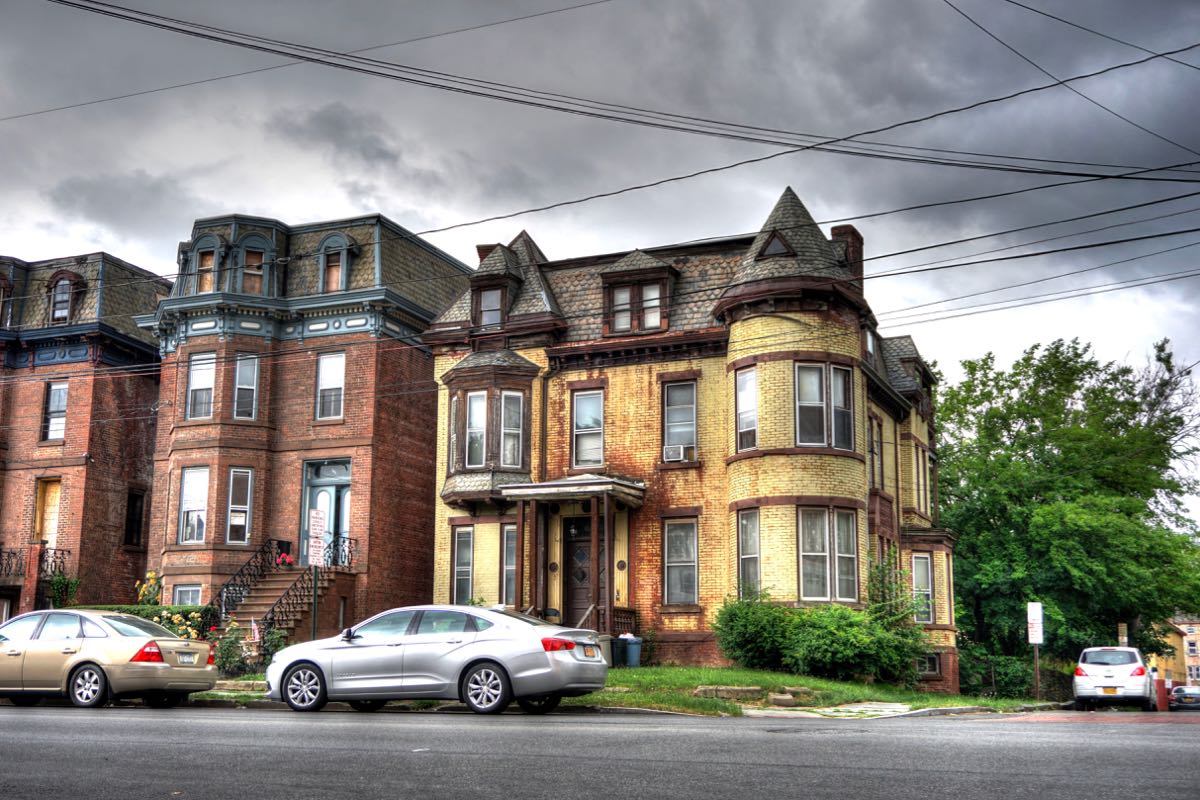
My favorite is undoubtedly the 1835 Dutch Reformed Church, which was designed by the noted New York architect Alexander Jackson Davis. The church closed in 1967 and narrowly escaped destruction-by-urban-renewal at that time. Efforts have been underway for decades to raise funds for its renovation, but to date the only sign of progress is that the four front pillars have been repaired and repainted. Encouragingly, on the day of my visit several ladies from a local support group were energetically tidying up the landscaping. This church deserves to be rescued, but it just isn’t happening fast enough. Visit soon.


The Calvary Presbyterian Church was built 23 years after the Dutch Reformed Church but has fared much better. It stands on the grounds of the original Old Town Cemetery and services are still held regularly. Calvary Presbyterian became the first church in New York to install electric lights, based on Thomas Edison’s personal exhortations to the trustees. (They kept the old gaslights for many years “just in case.”)

Newburgh’s Old Town Cemetery is the final resting place of as many as 2,500 individuals, with graves dating back to at least the mid-1700s. Captain Henry “Bully” Robinson built this prominent, Egyptian-themed mausoleum for his wife Ann when she passed away in 1853. He joined her there 13 years later. The mausoleum is said to have been designed by Alexander Jackson Davis. Captain Robinson traveled throughout the world, fought bravely in the War of 1812, and originated many sports activities in Newburgh, including the Newburgh Regatta. However, he might be best known for having brought the first goldfish to America… (Robinson’s nickname of “Bully,” incidentally, was meant in the good way, as in “bully for you!”)

Alexander Jackson Davis was not the only renowned architect to have designed buildings in Newburgh. Andrew Jackson Downing (1815-1852) was born here and soon became known as the founder of American landscape architecture. He later turned his attention to architecture and published the pattern book Cottage Residences in 1842, with Davis as co-author. Their book’s designs ranged from modest farmhouses to ornate villas and were used throughout the U.S. for the next 50 years. Downing also convinced English architects Calvert Vaux and Frederick Clarke Withers to join his firm, where, among other projects, they designed the grounds of the White House and the Smithsonian Institution. Sadly, Downing was killed in 1852 while traveling to New York City on the steamship Henry Clay. The ferry was racing another ship down the Hudson when its boiler exploded and caught fire.

Montgomery Street, overlooking the Hudson, has a stunning array of beautiful mansions. This one was my favorite, and I later learned that it was the Warren Coldwell home, designed by Calvert Vaux in the Downing fashion.

Downing and Vaux had a young apprentice named Frederick Law Olmstead, who would go on to become the most celebrated landscape designer of the time. Everyone knows that Central Park in New York City was designed by Olmstead, but many forget that it was done in partnership with Vaux. And that Downing first suggested such a park in New York City. From left to right: Alexander Jackson Davis, Andrew Jackson Downing, Calvert Vaux, and Frederick Law Olmstead.
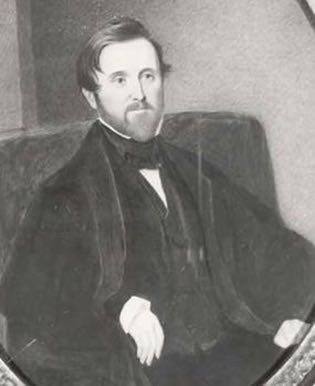


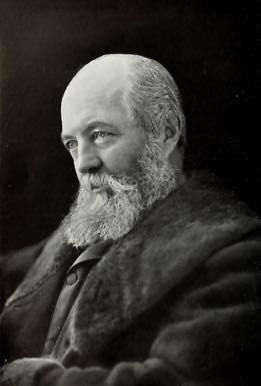
David Crawford (1788-1856) came to Newburgh with his parents and siblings in 1806. Following the death of his mother and all three of his brothers from tuberculosis, he became a deputy sheriff. During the War of 1812, he served as a Captain in the artillery regiment guarding New York Harbor. Afterwards, he became a successful shipper, transporting passengers and goods between Newburgh and New York City. Some credit Crawford with being the first to bring back a goldfish from China, but most historians side with Bully Robinson on this important issue. (Drawings of David and his wife Fanny Crawford courtesy of the Historical Society of Newburgh Bay and the Highlands.)


By 1830, David and Fanny were able to build this mansion on Montgomery Street, overlooking the Hudson River. They leased the land from the Newburgh “Trustees of the Glebe.” (Little known fact: This lease will expire on March 29, 2730.) The house was slated to be demolished in 1953 and replaced with a parking lot for the funeral home next door. Thankfully, the Historical Society swooped in, bought the historic home, and turned it into a museum and research center. Tours are available by appointment.
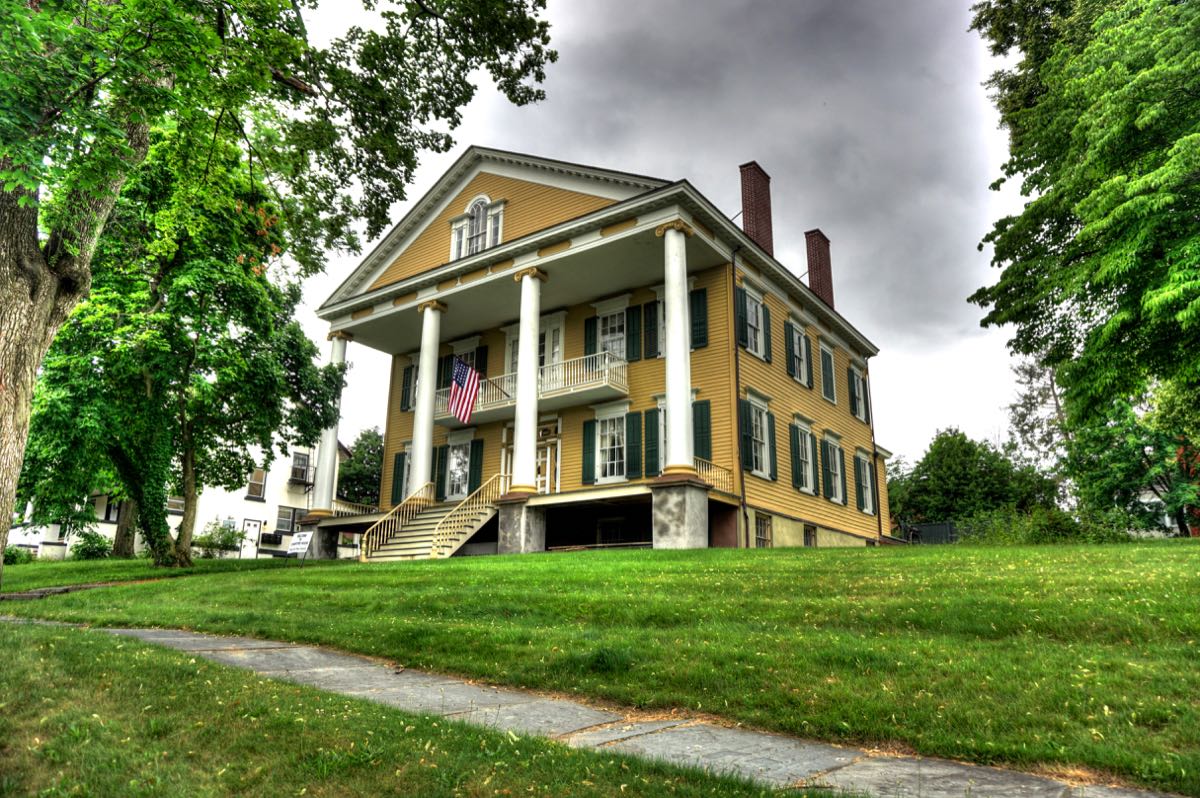
An excellent photo essay on the Crawford House was created by the late John Foreman and is available at Big Old Houses. (Interior photos courtesy of the Library of Congress.)


The awesome SL550 did not look at all out of place among the mansions on Montgomery Street.

With my touring time having already expired, I took a quick look at Front Street. Urban renewal had demolished the great majority of the buildings and neighborhoods here, but this massive old factory somehow survived. It started out in 1845 as the Newburgh Steam Mill, manufacturing cotton cloth. Competition from southern mills led to the closure of the Steam Mill in 1892, but by 1910 the Coldwell Lawnmower Company was building 200 mowers a day here. (Eventually that company ended up as a piece of Toro.) In 1947, a handbag manufacturer set up shop here and continued through the early 2000s. Today, artist studios are available for lease on the fourth, fifth, and sixth floors.


In the distance is the Newburgh-Beacon Bridge over the Hudson. Expect delays, since it’s the only crossing for about 15 miles in either direction.

The large-scale development plans for Front Street were never implemented (other than the nice brick sidewalk I parked next to). As a result, this stretch of prime real estate along the river is pretty much vacant. During my time here, not a single car or pedestrian went by.

I had heard of the Frontenac racing cars that won the Indianapolis 500 in 1920 and 1921, using speed equipment manufactured by the Chevrolet Brothers. But until this trip I never realized that there was also an earlier, unrelated American company that produced Frontenac automobiles—in Newburgh. That’s perhaps understandable, given that the company was only in business during 1906-1913 and only produced a total of 50 to 100 cars. They cost between $3,500 and $5,000 at a time when a new Cadillac was just $1,000. This was the Abendroth & Root Manufacturing Company that produced the Frontenacs. (Drawing of the Frontenac Limousine courtesy of the Times Herald-Record. Photo of Fire Department Chiefs in a Frontenac Touring model courtesy of the Historical Society of Newburgh Bay & The Highlands.)
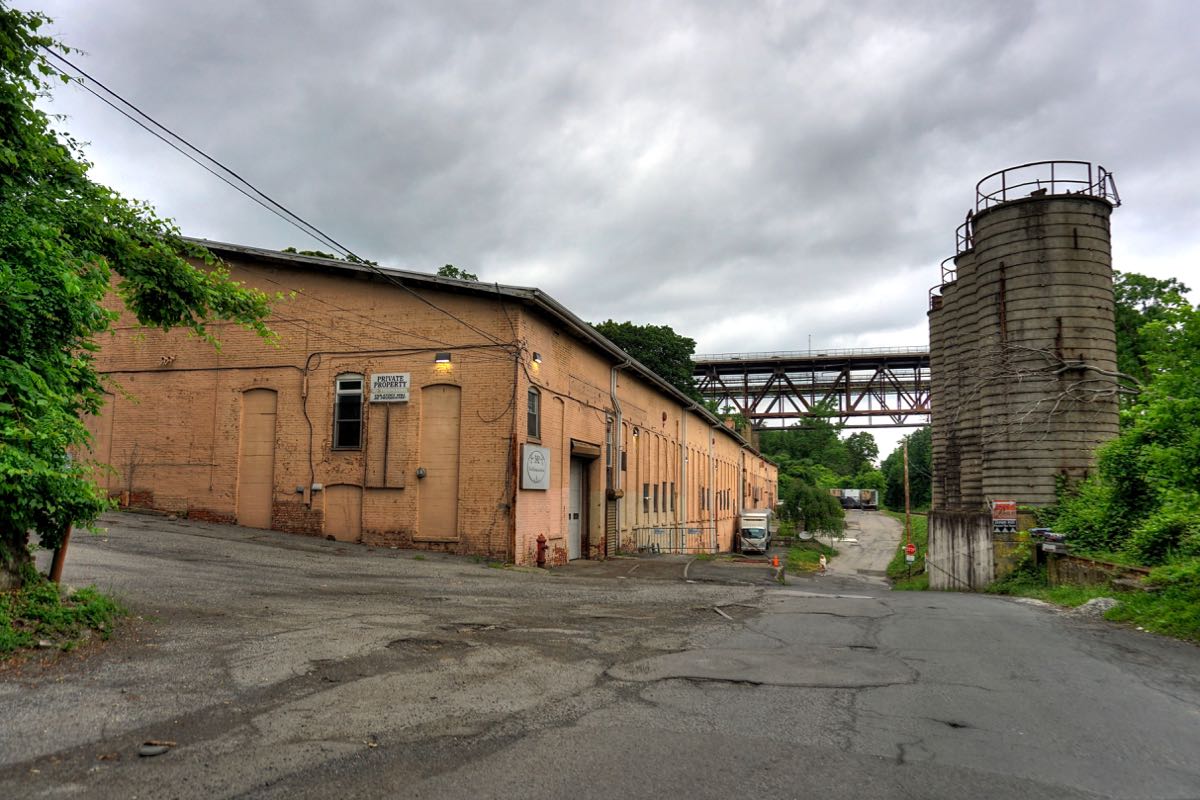
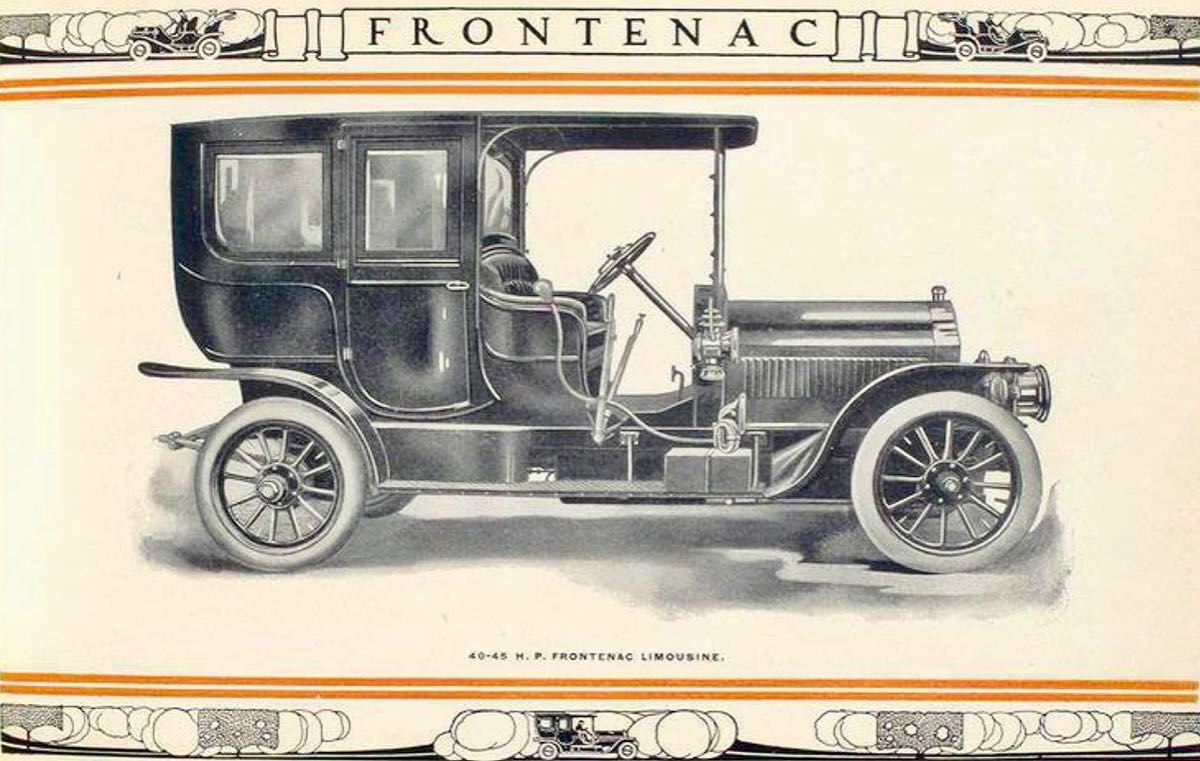

I had just one more place to find in Newburgh before hightailing it to Cape Cod: The smallest state forest in New York (and probably anywhere in the United States). Legends are wonderful things: George Washington is said to have planted his walking stick north of Newburgh at the end of the Revolutionary War, with said walking stick taking root and eventually growing into the 110-foot-tall Balmville Tree. The tree, however, was later determined to date back to 1699, well before Washington was even born. It was the oldest eastern cottonwood tree east of the Mississippi River.

By the 1950s, sadly, the Balmville Tree was deteriorating, and by the 1970s it was a serious hazard to passing motorists and pedestrians. Thus began a long fight over whether to cut down the tree or to (somehow) preserve it. The preservationists prevailed for quite some time, and in 2000 the tree was added to the prestigious National Register of Historic Places. In 2015, however, the Balmville Tree had to be taken down, and now only a 15-foot section of the trunk remains—but it is an official New York State Forest!
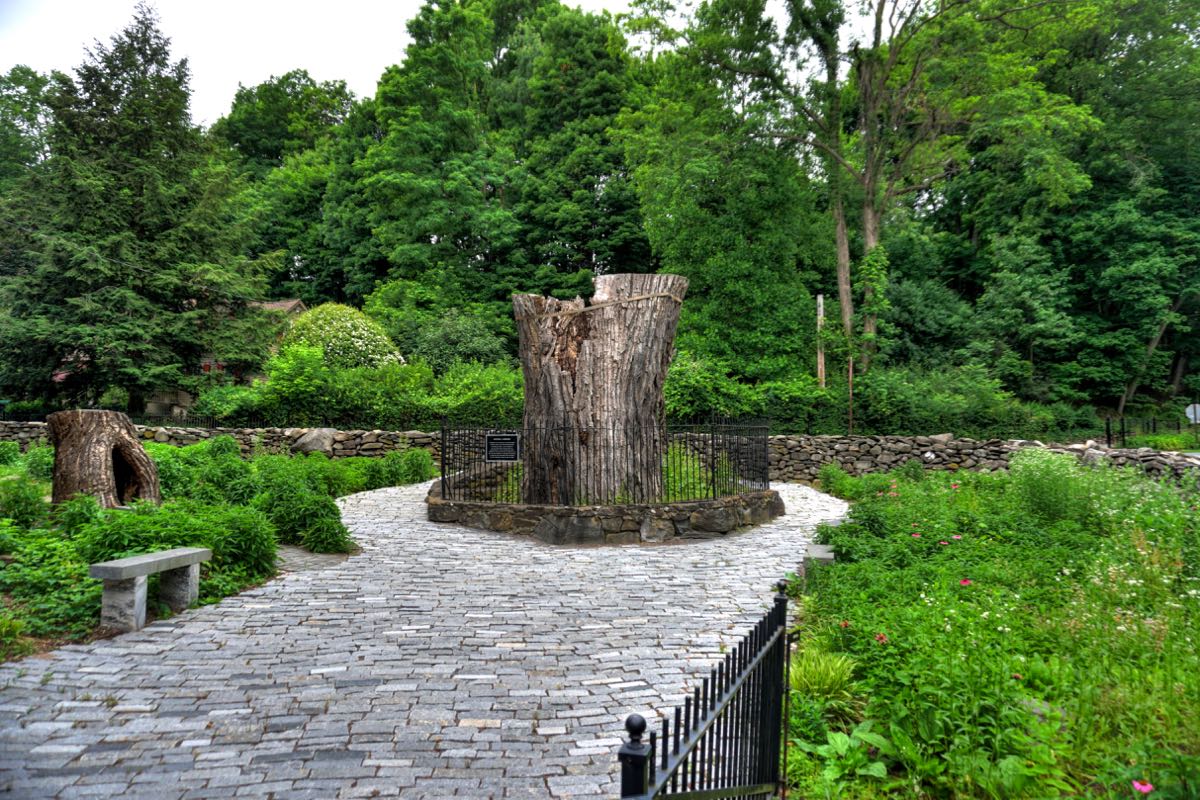
From the Balmville Tree to East Falmouth, Cape Cod was just a quick 259 miles further on, and I arrived in time to have dessert with my wife Nancy and our friend Martha. The Newburgh visit was one of my briefer excursions, but it was certainly packed with interesting places. The SL550 ran perfectly throughout, whether creeping along in search of forgotten places or tearing across Massachusetts at unsanctioned speeds. I’ll definitely return for more exploration—and I’ll be sure to keep a low profile while I’m there.
Rick F.
How to ruin a city with good intentions
I had just enough time to see a few more sights in Newburgh, and I tried to make the most of it.

In its heyday, Newburgh was a powerhouse of manufacturing, shipbuilding, and transportation. Located on the Hudson River midway between New York City and the capital of Albany, it was once the world’s largest producer of handbags, steam generation equipment, and lawnmowers. Per freelance journalist Lynn Woods, “The city had five movie theaters, two roller skating rinks, 15 auto showrooms, dozens of barbershops, 50 clothing stores, … 66 restaurants, 16 jewelry stores, and 25 clothing manufacturers.


With the advent of highways, trucking, and suburban development, Newburgh began a long economic decline. River and railroad transportation became less needed, and the construction in 1963 of the Newburgh-Beacon bridge over the Hudson bypassed the downtown area altogether.
Moreover, Newburgh is often cited as one of the foremost examples of catastrophe resulting from the wave of “urban renewal” that swept through many cities in the 1960s and 1970s. These programs were intended to reverse Newburgh’s decline and result in sweeping improvements in the city’s quality of life. Lynn Woods wrote an eye-opening, three-part article entitled “Lost Newburgh: The Tragedy of Urban Renewal”, which graphically described what happened in the city. Per Ms. Woods, “Approximately 1,300 buildings were demolished, annihilating the downtown commercial district, which dated back to the 1820s. Nine streets were plowed under… The city’s African American community was uprooted, with thousands of businesses and residents displaced. Adding insult to injury, … the promised rebuilding mostly didn’t happen.” (Urban renewal photos courtesy of Ms. Woods’ article.)

In Newburgh, three phases of demolition were completed, including the removal of the city’s historic and active downtown business district along with viable nearby neighborhoods inaccurately characterized by city managers as “slums” and “ghettos.” Many low-income families had to relocate multiple times, as one after another of their homes were seized through eminent domain and razed. Many of the affected families went from being homeowners to renters, and many gainfully employed individuals lost their jobs when businesses were demolished. Ms. Woods quoted from Newburgh’s Evening News, “The area looked like a shell-shattered town of some gigantic war. Now with all the buildings gone it has become an undulating wasteland of weeds.” She concluded, “Thirteen years after the first urban renewal plan was approved, the big development hadn’t happened, an irreplaceable architectural heritage had been lost, and a vibrant working-class community destroyed.” Now, almost 50 years after the demolition, not much has changed.

In addition to people’s houses, urban renewal destroyed many historic business buildings and other structures, including the Newburgh Savings Bank…


…the Pallantine Hotel…

…and the Homer Ramsdell mansion.

Efforts since the 1970s to rebuild and revitalize Newburgh have had some limited success. Nonetheless, NeighborhooodScout found that Newburgh’s “violent crime rate is one of the highest in the nation, across communities of all sizes (both large and small).” The website calculates the current annual probability of experiencing either a violent crime or property crime in Newburgh to be 1 in 28… Let us hope that the city’s modest progress in recent years will continue—and improve substantially.
Architects and landscape designers
Despite Newburgh’s decline and intimidating crime statistics, I knew from prior visits that there are still many interesting old places to see.

My favorite is undoubtedly the 1835 Dutch Reformed Church, which was designed by the noted New York architect Alexander Jackson Davis. The church closed in 1967 and narrowly escaped destruction-by-urban-renewal at that time. Efforts have been underway for decades to raise funds for its renovation, but to date the only sign of progress is that the four front pillars have been repaired and repainted. Encouragingly, on the day of my visit several ladies from a local support group were energetically tidying up the landscaping. This church deserves to be rescued, but it just isn’t happening fast enough. Visit soon.


The Calvary Presbyterian Church was built 23 years after the Dutch Reformed Church but has fared much better. It stands on the grounds of the original Old Town Cemetery and services are still held regularly. Calvary Presbyterian became the first church in New York to install electric lights, based on Thomas Edison’s personal exhortations to the trustees. (They kept the old gaslights for many years “just in case.”)

Newburgh’s Old Town Cemetery is the final resting place of as many as 2,500 individuals, with graves dating back to at least the mid-1700s. Captain Henry “Bully” Robinson built this prominent, Egyptian-themed mausoleum for his wife Ann when she passed away in 1853. He joined her there 13 years later. The mausoleum is said to have been designed by Alexander Jackson Davis. Captain Robinson traveled throughout the world, fought bravely in the War of 1812, and originated many sports activities in Newburgh, including the Newburgh Regatta. However, he might be best known for having brought the first goldfish to America… (Robinson’s nickname of “Bully,” incidentally, was meant in the good way, as in “bully for you!”)

Alexander Jackson Davis was not the only renowned architect to have designed buildings in Newburgh. Andrew Jackson Downing (1815-1852) was born here and soon became known as the founder of American landscape architecture. He later turned his attention to architecture and published the pattern book Cottage Residences in 1842, with Davis as co-author. Their book’s designs ranged from modest farmhouses to ornate villas and were used throughout the U.S. for the next 50 years. Downing also convinced English architects Calvert Vaux and Frederick Clarke Withers to join his firm, where, among other projects, they designed the grounds of the White House and the Smithsonian Institution. Sadly, Downing was killed in 1852 while traveling to New York City on the steamship Henry Clay. The ferry was racing another ship down the Hudson when its boiler exploded and caught fire.

Montgomery Street, overlooking the Hudson, has a stunning array of beautiful mansions. This one was my favorite, and I later learned that it was the Warren Coldwell home, designed by Calvert Vaux in the Downing fashion.

Downing and Vaux had a young apprentice named Frederick Law Olmstead, who would go on to become the most celebrated landscape designer of the time. Everyone knows that Central Park in New York City was designed by Olmstead, but many forget that it was done in partnership with Vaux. And that Downing first suggested such a park in New York City. From left to right: Alexander Jackson Davis, Andrew Jackson Downing, Calvert Vaux, and Frederick Law Olmstead.




David Crawford (1788-1856) came to Newburgh with his parents and siblings in 1806. Following the death of his mother and all three of his brothers from tuberculosis, he became a deputy sheriff. During the War of 1812, he served as a Captain in the artillery regiment guarding New York Harbor. Afterwards, he became a successful shipper, transporting passengers and goods between Newburgh and New York City. Some credit Crawford with being the first to bring back a goldfish from China, but most historians side with Bully Robinson on this important issue. (Drawings of David and his wife Fanny Crawford courtesy of the Historical Society of Newburgh Bay and the Highlands.)


By 1830, David and Fanny were able to build this mansion on Montgomery Street, overlooking the Hudson River. They leased the land from the Newburgh “Trustees of the Glebe.” (Little known fact: This lease will expire on March 29, 2730.) The house was slated to be demolished in 1953 and replaced with a parking lot for the funeral home next door. Thankfully, the Historical Society swooped in, bought the historic home, and turned it into a museum and research center. Tours are available by appointment.

An excellent photo essay on the Crawford House was created by the late John Foreman and is available at Big Old Houses. (Interior photos courtesy of the Library of Congress.)


The awesome SL550 did not look at all out of place among the mansions on Montgomery Street.

With my touring time having already expired, I took a quick look at Front Street. Urban renewal had demolished the great majority of the buildings and neighborhoods here, but this massive old factory somehow survived. It started out in 1845 as the Newburgh Steam Mill, manufacturing cotton cloth. Competition from southern mills led to the closure of the Steam Mill in 1892, but by 1910 the Coldwell Lawnmower Company was building 200 mowers a day here. (Eventually that company ended up as a piece of Toro.) In 1947, a handbag manufacturer set up shop here and continued through the early 2000s. Today, artist studios are available for lease on the fourth, fifth, and sixth floors.


In the distance is the Newburgh-Beacon Bridge over the Hudson. Expect delays, since it’s the only crossing for about 15 miles in either direction.

The large-scale development plans for Front Street were never implemented (other than the nice brick sidewalk I parked next to). As a result, this stretch of prime real estate along the river is pretty much vacant. During my time here, not a single car or pedestrian went by.

I had heard of the Frontenac racing cars that won the Indianapolis 500 in 1920 and 1921, using speed equipment manufactured by the Chevrolet Brothers. But until this trip I never realized that there was also an earlier, unrelated American company that produced Frontenac automobiles—in Newburgh. That’s perhaps understandable, given that the company was only in business during 1906-1913 and only produced a total of 50 to 100 cars. They cost between $3,500 and $5,000 at a time when a new Cadillac was just $1,000. This was the Abendroth & Root Manufacturing Company that produced the Frontenacs. (Drawing of the Frontenac Limousine courtesy of the Times Herald-Record. Photo of Fire Department Chiefs in a Frontenac Touring model courtesy of the Historical Society of Newburgh Bay & The Highlands.)



I had just one more place to find in Newburgh before hightailing it to Cape Cod: The smallest state forest in New York (and probably anywhere in the United States). Legends are wonderful things: George Washington is said to have planted his walking stick north of Newburgh at the end of the Revolutionary War, with said walking stick taking root and eventually growing into the 110-foot-tall Balmville Tree. The tree, however, was later determined to date back to 1699, well before Washington was even born. It was the oldest eastern cottonwood tree east of the Mississippi River.

By the 1950s, sadly, the Balmville Tree was deteriorating, and by the 1970s it was a serious hazard to passing motorists and pedestrians. Thus began a long fight over whether to cut down the tree or to (somehow) preserve it. The preservationists prevailed for quite some time, and in 2000 the tree was added to the prestigious National Register of Historic Places. In 2015, however, the Balmville Tree had to be taken down, and now only a 15-foot section of the trunk remains—but it is an official New York State Forest!

From the Balmville Tree to East Falmouth, Cape Cod was just a quick 259 miles further on, and I arrived in time to have dessert with my wife Nancy and our friend Martha. The Newburgh visit was one of my briefer excursions, but it was certainly packed with interesting places. The SL550 ran perfectly throughout, whether creeping along in search of forgotten places or tearing across Massachusetts at unsanctioned speeds. I’ll definitely return for more exploration—and I’ll be sure to keep a low profile while I’m there.
Rick F.
The following 7 users liked this post by Rick F.:
Adi-Benz (11-26-2021),
chassis (11-26-2021),
crconsulting (11-26-2021),
E55Greasemonkey (11-30-2021),
ram_g (11-25-2021),
and 2 others liked this post.
#4
ram_g,
Thanks much, I'm glad you enjoyed it!
It's not the usual "how do I repair this?" or "should I buy that?" sort of thing, but it's a good example of the fun you can have touring in a Mercedes. It's hard to think of a better way to get to scenic, historic, or otherwise-interesting places!
Rick
Thanks much, I'm glad you enjoyed it!
It's not the usual "how do I repair this?" or "should I buy that?" sort of thing, but it's a good example of the fun you can have touring in a Mercedes. It's hard to think of a better way to get to scenic, historic, or otherwise-interesting places!
Rick
#6
Junior Member
Joined: Oct 2021
Posts: 24
Likes: 14
From: York,PA
2013 Sl550, 2012 CTS-V coupe, 2015 Grand Cherokee, 2014 Ram 2500
WOW! One hell of a post. Thanks for all the hard work. Have landed at Stewart numerous times, always wondered what the monolith was. Thanks for clearing that one up.
great looking 550 BTW. Have the same color with red interior, pre-facelift. Love the SL!!
great looking 550 BTW. Have the same color with red interior, pre-facelift. Love the SL!!
#7
Super Member
Joined: Sep 2014
Posts: 642
Likes: 277
From: Franklin, TN
2019 E450 wagon: 2019 BMW 430i: 2013 Chevy Traverse: (departed)2013 SL550 & 2019 E450 cab
Rick, ever since following your travelogues on the BMW site, and now here, I find your research, photos and descriptions to be most excellent! This one is just marvelously done! As noted before, you should really assemble them all into a book, just most special. Thanks for sharing!
One more item, I used to fly in and out of Newburgh when I had business in that area. One trip, I informed my Dad where I was headed, and his reply was 'Stewart Field'. He went on to tell me that he had flown AT-6's out of Steward during pilot training in WWII; the Army Air Corps pilots would fly the planes in the morning, and the West Point pilots in the afternoon. During one of the training flights, my father's instructor signaled that they should peel off and dive, so my Dad and the other trainee followed the instructor; they flew under the Bear Mountain Bridge over the Hudson. When they were called in after being reported, they passed the blame to the West Point pilots! Upon seeing the Bear Mountain Bridge, I was quite impressed that my fairly straight laced father had actually done that feat!
One more item, I used to fly in and out of Newburgh when I had business in that area. One trip, I informed my Dad where I was headed, and his reply was 'Stewart Field'. He went on to tell me that he had flown AT-6's out of Steward during pilot training in WWII; the Army Air Corps pilots would fly the planes in the morning, and the West Point pilots in the afternoon. During one of the training flights, my father's instructor signaled that they should peel off and dive, so my Dad and the other trainee followed the instructor; they flew under the Bear Mountain Bridge over the Hudson. When they were called in after being reported, they passed the blame to the West Point pilots! Upon seeing the Bear Mountain Bridge, I was quite impressed that my fairly straight laced father had actually done that feat!
Trending Topics
#9
Fantastic post! We have a lake house on the other side of the Hudson in Clinton Corners. What happened to Newburgh and Poughkeepsie are tough to see first hand. We often drive through Poughkeepsie and love the architecture and history but we don't stop for safety reasons. It's a shame...
#10
Great post! Thanks for sharing your trip in such interesting detail.
Favorite quote,
"Meanwhile, back to George Washington, who was traveling by horse in March 1782 and no doubt wishing he had a SatNav, soft-close doors, and AirScarf…"
Rick Steve's has nothing on you.
My paternal American origins are up the Hudson in a small town called Kinderhook.
Favorite quote,
"Meanwhile, back to George Washington, who was traveling by horse in March 1782 and no doubt wishing he had a SatNav, soft-close doors, and AirScarf…"
Rick Steve's has nothing on you.
My paternal American origins are up the Hudson in a small town called Kinderhook.
Last edited by MBNUT1; 11-26-2021 at 01:28 PM.
#11
#12
Great, I'm glad you liked the post!
I hope all your landings at Stewart International were on schedule, as opposed to Manifest's 5½ year late example. Smile
As for the SL550, it's a magnificent automobile. Very handsome, in an aggressive way, more than enough power, superb handling (and yet comfortable in Comfort mode), and tons of useful equipment, e.g., the more detailed engine information available on the display. I've been extremely happy with mine so far.
Rick
#13
Rick, ever since following your travelogues on the BMW site, and now here, I find your research, photos and descriptions to be most excellent! This one is just marvelously done! As noted before, you should really assemble them all into a book, just most special. Thanks for sharing!
One more item, I used to fly in and out of Newburgh when I had business in that area. One trip, I informed my Dad where I was headed, and his reply was 'Stewart Field'. He went on to tell me that he had flown AT-6's out of Steward during pilot training in WWII; the Army Air Corps pilots would fly the planes in the morning, and the West Point pilots in the afternoon. During one of the training flights, my father's instructor signaled that they should peel off and dive, so my Dad and the other trainee followed the instructor; they flew under the Bear Mountain Bridge over the Hudson. When they were called in after being reported, they passed the blame to the West Point pilots! Upon seeing the Bear Mountain Bridge, I was quite impressed that my fairly straight laced father had actually done that feat!
One more item, I used to fly in and out of Newburgh when I had business in that area. One trip, I informed my Dad where I was headed, and his reply was 'Stewart Field'. He went on to tell me that he had flown AT-6's out of Steward during pilot training in WWII; the Army Air Corps pilots would fly the planes in the morning, and the West Point pilots in the afternoon. During one of the training flights, my father's instructor signaled that they should peel off and dive, so my Dad and the other trainee followed the instructor; they flew under the Bear Mountain Bridge over the Hudson. When they were called in after being reported, they passed the blame to the West Point pilots! Upon seeing the Bear Mountain Bridge, I was quite impressed that my fairly straight laced father had actually done that feat!
You've been a regular reader for a long time, and I always appreciate your comments. One of these days I'll take my favorite 20 or so reports and turn them into a book. I've done something like 150 reports in total so far, each with anywhere between 30 and 200 photos, so including everything would take a number of volumes. Unless the photos were really small, which I'd hate to do.
Your Dad's story about flying under the Bear Mountain Bridge is fascinating! Stewart Field was originally built in 1934 to serve as a training airfield for the West Point cadets. As your Dad noted, it was later used to train pilots for World War II as well. The deck of the bridge is about 150 feet above the Hudson. Approaching at a speed of somewhere between 100 and 200 mph, I can imagine that the space looked really tight! Especially for a low-wing trainer like the AT-6, where you can't get a good view of the ground (or water) below the plane. Good for your Dad! Wink
Rick
The following users liked this post:
TennesseeZ4 (11-28-2021)
#14
I'm glad you enjoyed the trip report! I'm always amazed at how much history has occurred at almost any single spot in the eastern U.S. Before the trip, I knew nothing about the Newburgh Conspiracy or how George Washington nipped it in the bud. Imagine if he hadn't succeeded, and the Army had directly attacked Congress! It reminds me of the time that a Springfield lawyer challenged Abraham Lincoln to a duel, and Lincoln accepted. Think how that could have turned out… (You can find that story at In Pursuit of the Grey Ghost.)
Rick
#15
Fantastic post! We have a lake house on the other side of the Hudson in Clinton Corners. What happened to Newburgh and Poughkeepsie are tough to see first hand. We often drive through Poughkeepsie and love the architecture and history but we don't stop for safety reasons. It's a shame...
Thanks!
I couldn't agree more about the unfortunate history of Newburgh, Poughkeepsie, and certain other cities in New York. History is created over many decades or even centuries, but it takes only hours to destroy it with a wrecking ball. I gather that a few cities have managed to recover fairly well from their urban renewal trauma. But Newburgh is a long way from any such success, unfortunately.
Rick
The following users liked this post:
emilner (11-27-2021)
#16
Great post! Thanks for sharing your trip in such interesting detail.
Favorite quote,
"Meanwhile, back to George Washington, who was traveling by horse in March 1782 and no doubt wishing he had a SatNav, soft-close doors, and AirScarf…"
Rick Steve's has nothing on you.
My paternal American origins are up the Hudson in a small town called Kinderhook.
Favorite quote,
"Meanwhile, back to George Washington, who was traveling by horse in March 1782 and no doubt wishing he had a SatNav, soft-close doors, and AirScarf…"
Rick Steve's has nothing on you.
My paternal American origins are up the Hudson in a small town called Kinderhook.
Yeah, I couldn't resist the temptation to invent George Washington's desire for some modern conveniences. It's pretty amazing to consider how many breakthroughs have occurred just within our lifetimes. My little grand-nieces have no conception of what it was like without a cell phone!
I drove through Kinderhook some years ago, on my first trip through the Hudson River Valley. It's a beautiful area and is loaded with interesting history. I need to return for more exploration!
Rick
#17
Enjoyed the post and pictures. I grew up nearby in Westchester County during the 50's & 60's and had relatives that lived on the outskirts of Newburgh. We made quite a few trips there before we fled NY and it'svery interesting to see some of the old sites to stimulate memories of the past.
#18
MBNUT1,
Yeah, I couldn't resist the temptation to invent George Washington's desire for some modern conveniences. It's pretty amazing to consider how many breakthroughs have occurred just within our lifetimes. My little grand-nieces have no conception of what it was like without a cell phone!
I drove through Kinderhook some years ago, on my first trip through the Hudson River Valley. It's a beautiful area and is loaded with interesting history. I need to return for more exploration!
Rick
Yeah, I couldn't resist the temptation to invent George Washington's desire for some modern conveniences. It's pretty amazing to consider how many breakthroughs have occurred just within our lifetimes. My little grand-nieces have no conception of what it was like without a cell phone!
I drove through Kinderhook some years ago, on my first trip through the Hudson River Valley. It's a beautiful area and is loaded with interesting history. I need to return for more exploration!
Rick
Last edited by MBNUT1; 11-26-2021 at 09:08 PM.
#19
Enjoyed the post and pictures. I grew up nearby in Westchester County during the 50's & 60's and had relatives that lived on the outskirts of Newburgh. We made quite a few trips there before we fled NY and it'svery interesting to see some of the old sites to stimulate memories of the past.
I'm glad you enjoyed the report! I thoroughly enjoyed my time there and found Newburgh to be a fascinating place.
Newburgh is a good example of what happens when the economic forces affecting a city change, but the city doesn't adapt to those changes quickly or effectively. When railroads were developing along the Hudson River, the owners of Newburgh's steamship companies realized that their thriving businesses were now at risk. Several of them (including David Crawford and Homer Ramsdell) banded together to build the cotton cloth factory. Moreover, they introduced steam power, when the New England textile factories were all still using water power. The Newburgh proprietors proactively turned to manufacturing and they created a new demand for their shipping services, since the factory needed quantities of cotton to be brought to Newburgh from the South. It was a great example of changing with the circumstances.
Later, however, the railroads declined as a result of road construction, many businesses experienced strong competition from Southern and foreign competitors where wages were lower, and other businesses left to escape the rising state and local taxes in New York. New businesses, say, in computers and other technology, did not form, and the city engaged in urban renewal that destroyed many of the smaller businesses that had been doing okay. The necessary adaptation just didn't occur—although, in fairness, it would have been very difficult to succeed under the circumstances.
Rick
#20
#21
My grandfather of the same last name was from up the road in Albany. He and his partner started Standard Motor Products. The old guys on the board have probably heard of Blue Streak spark plugs. I've seen a picture of him sitting on an Indian Motorcycle on the Indy racetrack with Floyd Clymer of Clymer's Auto Repair manuals standing there.
Last edited by MBNUT1; 11-27-2021 at 10:58 PM.
#22
Junior Member
Joined: Dec 2020
Posts: 62
Likes: 7
From: Iowa
2020 SL550 2022 E450 sedan 2018 silverado
My grand daughter graduated from West Point in 2017. We stayed on base four different times during her time at West Point a beautiful place. We drove up to see Newburgh one time what a shame.
#23
Congratulations to your daughter for graduating from West Point, and many thanks as well for her military service on behalf of the U.S. As I mentioned in the report, we tend to take such service for granted. But for those of us with relatives in the military, or with such service of our own, we are very aware of both the outstanding dedication and skill of these individuals and their physical and fiscal sacrifices on behalf of us all.
I did a tour of West Point on one of my trips a few years back. It was a fascinating place, both currently and historically. I hope they've finished the renovations to the chapel by now. My trip report is available at Touring New York and New England, In Search of Lavender, Sam, and Alice if you're interested. (It remains one of my all-time favorite trips.)
Rick
#25








